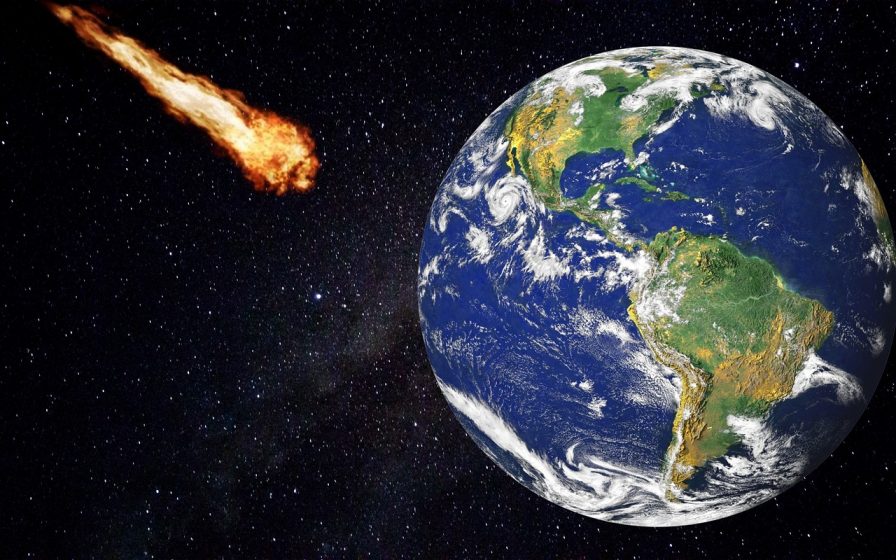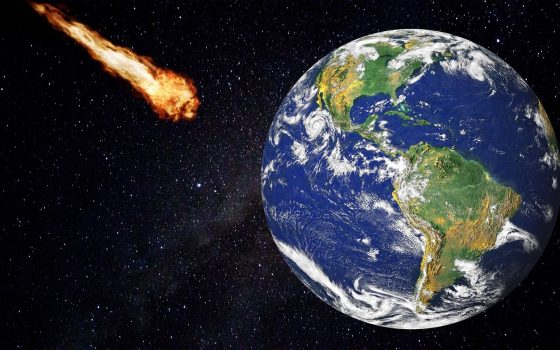
 Did you know that NASA is going to send a spacecraft on a suicide mission in an effort to alter the trajectory of an enormous space rock? Fortunately is that the space rock that NASA will be crashing this spacecraft into is not on a collision course with Earth. It is just a test. However why has NASA all of a sudden end up being so concerned with finding out how to safeguard the Earth from giant asteroids? Could it be possible that there is something heading towards Earth in the future that they haven’t told us about yet?
Did you know that NASA is going to send a spacecraft on a suicide mission in an effort to alter the trajectory of an enormous space rock? Fortunately is that the space rock that NASA will be crashing this spacecraft into is not on a collision course with Earth. It is just a test. However why has NASA all of a sudden end up being so concerned with finding out how to safeguard the Earth from giant asteroids? Could it be possible that there is something heading towards Earth in the future that they haven’t told us about yet?
According to NASA, there are more than 26,000 asteroids that pass near Earth, and more than 2,000 of them are categorized as “potentially dangerous” asteroids.
The majority of those “possibly harmful” asteroids aren’t that big, however 158 of them do have a diameter of more than one kilometer.
If one of those beasts were to hit us, it would be a catastrophe of cataclysmic proportions.
Naturally there are many other area rocks that our researchers have actually not found yet, and those probably represent the greatest danger. Because if you don’t see a hazard coming, you can’t get gotten ready for it ahead of time.
Nowadays, NASA authorities have actually become rather preoccupied by the danger that huge space rocks possibly posture, and we are being informed that “scientists are at work on a strategy to avoid the damage of Earth by an errant asteroid”. The following comes from a short article that was simply released by the Boston Globe…
NASA and a cadre of the world’s leading engineers and area scientists are at work on a plan to prevent the destruction of Earth by an errant asteroid like the one 65 million years ago that wiped out the dinosaurs, produced a cloud of dust so impenetrable that it blocked out the sun, and plunged the world into an extended winter season that sent out half of all plant life into termination.
Personally, I believe that this is something that NASA ought to certainly be concentrating on, due to the fact that the danger is extremely genuine.
Most people do not understand this, but our world is in fact being assailed by area debris on a consistent basis at this point. In truth, NASA states that we are being hit by really little objects “every day”…
Every day, Earth is bombarded by tons of dust and sand-sized particles from the planetary system. Meteoroids burn up as they enter the Earth’s atmosphere causing little or no damage. They are easy to find, spotting throughout the night sky in dazzling, temporary bursts of light. Of more concern are the asteroids that go by Earth unnoticed; they are difficult to spot and track as observers depend upon shown sunshine to spot them.
Fortunately, the huge bulk of the items that we experience are too little to do any damage.
However it is simply a matter of time before a truly huge area rock occurs.
NASA officials like to give the impression that they have a really excellent idea of what is going on up there, but the fact is that our ability to find large space rocks is still quite minimal. In Might, a “potentially dangerous” asteroid that came close to Earth was only discovered about a week before it showed up…
The reason that 2021 KT1 is news is that NASA estimates that it’s between 492 feet/150 meters and 1,082 feet/330 meters in size. It wasn’t observed till late in May 2021 simply a week prior to its closest pass.
And late last year a fairly big asteroid was not discovered up until it had actually currently buzzed alarmingly near to our world…
Wow. A low-flying space rock set a record last Friday (properly, the 13th), when 2020 VT4 passed simply under 400 kilometers (250 miles) over the Southern Pacific.
The asteroid was found by the Asteroid Terrestrial-impact Last Alert System (ATLAS) study at the Mauna Loa Observatory in Hawaii in the early morning hours of Saturday, November 14th, simply 15 hours after technique. This is not unusual for fast-movers, particularly asteroids that are coming at the Earth from our sunward blind-spot, like 2020 VT4.
So if a major threat is headed our way, we may or might not see it being available in advance.
If we do have advance caution that a substantial asteroid is coming, obviously we would want to try to do something about it. With such a scenario in mind, NASA will soon be crashing the DART spacecraft into a huge area rock called Dimorphos…
Established by a group of scientists from the Johns Hopkins University Applied Physics Laboratory and NASA’s Planetary Defense Coordination Office, DART is an unmanned, remotely managed huge suicide objective created to nudge an asteroid that is half a mile in size out of its orbit. Doomsayers take note: This is only a test. The asteroid in question, Didymos– Greek for “twin,” and so named because it was found to be coupled with its own little moon– is not actually on a clash with Earth.
At some point between Thanksgiving week (perhaps as soon as the evening of Nov. 23) and February 2022, the team behind DART will introduce it from Vandenberg Area Force Base in California on a SpaceX Falcon 9 rocket. The spacecraft will, if all goes according to strategy, travel 6.8 million miles to reach and hit Didymos’s moonlet, Dimorphos, which is 525 feet in diameter.
Is NASA testing out technology that they prepare to utilize on another giant area rock at a later date?
Some have recommended that an asteroid called Apophis might strike us on April 13th, 2029…
On April 13, 2029 (which happens to be Friday the 13th), something disturbing will happen.
A decent-sized asteroid, the 1,100-foot-wide Apophis, will pass so near Earth it’ll be visible in the sky from certain places. Crucially, the huge rock will not strike our humble planet. But it will pass closer than 20,000 miles from the surface, which is closer than where a few of the United States’ most valued weather satellites orbit.
However NASA insists that Apophis will not strike us “for at least a century”…
After its discovery in 2004, asteroid 99942 Apophis had actually been determined as one of the most hazardous asteroids that might affect Earth. But that effect evaluation changed as astronomers tracked Apophis and its orbit became better determined.
Now, the arise from a new radar observation campaign integrated with accurate orbit analysis have helped astronomers conclude that there is no danger of Apophis affecting our world for a minimum of a century.
Estimated to be about 1,100 feet (340 meters) throughout, Apophis quickly acquired prestige as an asteroid that could position a serious threat to Earth when astronomers predicted that it would come annoyingly close in 2029. Thanks to extra observations of the near-Earth object (NEO), the danger of an effect in 2029 was later on eliminated, as was the prospective impact risk postured by another close method in 2036.
The orbit of Apophis is now extremely well known by astronomers all over the globe. To me, all of the giant area rocks that are floating around up there that we do not learn about represent a much greater threat.
Sadly, the variety of large space rocks going by our planet has actually been progressively increasing, and I believe that there is a likelihood that we could see an asteroid effect long previously 2029 ever rolls around.
If NASA officials learn about such a danger, in the meantime they aren’t admitting that to the general public.
But they are confessing that they are trying to figure out how to deflect a large asteroid, and that need to certainly be getting our attention.
*** Michael’s brand-new book entitled “Lost Prophecies Of The Future Of America” is now readily available in paperbackand for the Kindleon Amazon. ***
About the Author: My name is Michael Snyder and my brand brand-new bookentitled”Lost Prophecies Of The Future Of America”is now readily available on Amazon.com. In addition to my brand-new book, I have composed four others that are available on Amazon.comconsisting of The Starting Of Completion, Get Prepared Now, and Living A Life That Truly Matters. (#CommissionsEarned) By buying the books you assist to support the work that my other half and I are doing, and by providing it to others you assist to multiply the impact that we are having on people all over the world. I have actually published countless short articles on The Economic Collapse Blog, End Of The American Dreamand The Most Essential News, and the articles that I publish on those websites are republished on lots of other popular websites all over the world. I constantly easily and happily allow others to republish my posts by themselves sites, but I likewise ask that they include this “About the Author” area with each article. The material included in this short article is for general info purposes only, and readers should consult certified professionals before making any legal, company, financial or health decisions. I motivate you to follow me on social media on Facebook, Twitterand Parler, and any method that you can share these posts with others is a terrific help. Throughout these really challenging times, individuals will need hope more than ever previously, and it is our objective to share the gospel of Jesus Christwith as many people as we possibly can.


